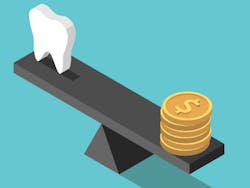This is a simple question that we’re asked often, from potential buyers looking at their first practice purchase, potential sellers looking to ensure their comfortable retirement, or practice owners looking to gauge the value of the practice they spent their professional lives building.
“What is this practice worth?” The answer, as you might imagine, is not simple.
There are a variety of factors that influence the value of a dental practice, and these factors are hard to analyze individually and even harder to gauge collectively. They can oftentimes be at odds, for example, a practice with declining revenue levels but increasing profitability levels.
While dental practice valuations are inherently complex, it’s possible to break down the value of a practice into an easy-to-understand format to help you make decisions that can have huge financial impacts on your life. I’ve outlined seven key factors to use when determining the value of a dental practice.
1. Revenue levels and trends
Practice value is heavily influenced by the revenue levels of the last three years. This is usually the period for which the accountant or lender reviews the practice tax returns or profit and loss (P&L) statements. While some practice analysts cite easy rules of thumb, such as “practice value is 75% of annual revenues,” this does not account for a variety of other factors that have a big influence on the value of a practice. Practices can succeed at a variety of revenue levels, therefore it’s important to evaluate several additional factors that heavily influence practice value.
2. Profitability levels and trends
Like other businesses, the value of a dental practice comes through the profits it derives for its owner. Looking at revenue levels alone is insufficient since this does not reveal how much cash the practice is producing for its owner. The average profitability range for a general dentistry practice is around 30%–40% of revenues, but this number can be deceivingly hard to compute.
Many of the practice expenses shown on the tax returns or P&L statements need to be adjusted to determine the true profitability of the practice. Accurately identifying these adjustments takes a high level of experience and expertise in the dental industry. We suggest using a dental-specific accountant who specializes in reviewing dental practices. This person will help identify all of the incoming cash flow hidden in the practice financials, which will help accurately determine the fair market value of the practice.
3. Type and size of patient base
New dental school grads and current associates often need to choose between starting a practice and acquiring an existing practice. Important factors to consider before an acquisition are the type of patient base (e.g., fee-for-service, PPO, Medicaid), size of the patient base (typically defined as the number of patients the practice has seen during the past 24 months), and the number of new patients per month. Identifying and analyzing these factors will allow potential buyers to weigh the pros and cons when deciding whether to start a practice or acquire a practice.
4. Hygiene production and type of dentistry
Hygiene production is the primary driver of doctor production in most practices. Therefore, it’s extremely important to have a strong hygiene program as this keeps patients coming in for continuing care, and it can significantly reduce the risk that comes with a practice transition.
The types of procedures performed by the owner-doctor or associates can also heavily impact value. Highly specialized practices result in more revenue being earned by the practice as opposed to making referrals to competitors. However, this might make it harder to attract a buyer with a comparable skill set who can continue to deliver the dentistry patients expect.
5. Facility and equipment
The type and quality of the facility and its equipment can play a major role in practice value. Current practice buyers often want practices located in retail spaces or free-standing buildings with good visibility, and computerized and paperless offices that are equipped with the latest and greatest dental equipment and technology. Making things even more complex, the presence or absence of these qualities may or may not have an impact on practice value. They may matter less for practices that are already earning substantial cash flow.
6. Location
Demand is a fundamental economic principle that has a substantial impact on the value of any asset. Demand is heavily influenced by location. We usually work with a demographics specialist to help us understand the population density, population growth rate, and median household income of the area surrounding a practice, as these impact the demand for practices in a given area. A separate evaluation can be done with a company that specializes in dental demographics to understand the concentration of dental practices in an area.
7. Opportunities for growth
Everyone wants to get a good deal when they make a big purchase. One way to do this is to ensure there are sufficient opportunities for growth within the practice. There are a number of key growth opportunities to look for when evaluating a practice. These include (1) expanding the operating hours or doctor’s schedule, (2) retaining more specialty procedures in-house, (3) having the ability to equip and use additional operatories, (4) having the ability to reduce specific expenses going forward, and (5) initiating marketing-related activities such as online reputation management or a new patient communication system. These opportunities can be a large source of hidden value for a potential practice buyer.
Determining the practice value
As you can see, there are a number of factors that can influence the value of a dental practice. You might be able to determine one or several of these factors yourself, but how will you know how much weight to assign to each or how they will all work together to arrive at a final practice value estimate? This answer is not simple, and that’s why it’s important to find a dental-specific accountant or analyst who knows the best way to weigh these factors to arrive at an accurate dental practice value.
Kevin Mach, CPA, is a founding partner of Dentappraisal, a company focused on providing independent, accurate, and easy-to-understand dental practice valuations to doctors nationwide. He became a licensed CPA after earning his degree in accounting and economics from Ohio State University. Prior to starting Dentappraisal, he worked as a dental practice underwriter at one of the largest dental lenders in the US, and for a Big Four public accounting firm.







